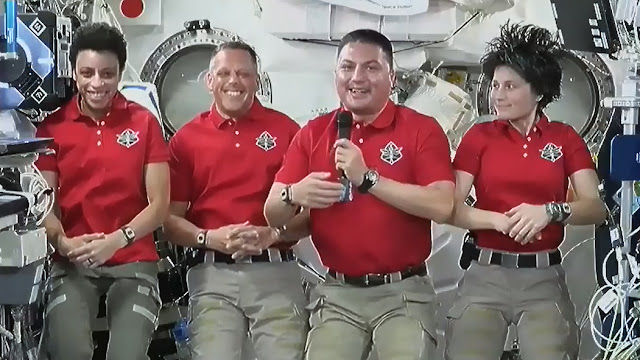ISS - Expedition 67 Mission patch.
June 28, 2022
The Expedition 67 crew said farewell to a U.S. cargo craft on Tuesday morning and is planning for the arrival of another resupply ship in mid-July. The seven International Space Station residents also split their day with a host of scientific and operational activities.
Northrop Grumman’s Cygnus space freighter completed its four-month cargo mission attached to the Unity module after the Canadarm2 robotic arm released it into Earth orbit at 7:07 a.m. EDT on Tuesday morning. The trash-filled commercial cargo craft will descend into Earth’s atmosphere and burn up safely above the Pacific Ocean on Wednesday. Cygnus delivered over 8,300 pounds of science and supplies when it arrived for capture and installation to Unity on Feb. 21, 2022.
Cygnus cargo departure from ISS. Animation Credit: ESA
The next resupply mission to visit the station is targeted for launch no earlier than July 14. The SpaceX Dragon cargo craft will be loaded with numerous new science experiments to investigate phenomena such as space-caused rapid aging, metabolic interactions in soil microbes, and cell-free production of proteins.
The station’s newest U.S. component, the NanoRacks Bishop airlock, was configured on Tuesday by NASA Flight Engineers Kjell Lindgren and Bob Hines. The duo removed cargo stowed inside the airlock and replaced it with a trash container that will be deployed this weekend outside the airlock to burn up harmlessly in Earth’s atmosphere. Bishop was delivered to the station aboard the SpaceX Dragon cargo craft on Dec. 6, 2020, and installed on the Tranquility module on Dec. 19.
Lindgren and NASA astronaut Jessica Watkins also took turns conducting a test simulating robotics maneuvers for the Behavioral Core Measures space psychology study. Watkins then joined Hines as they continued to film station operation videos to train future crew members on the ground.
Image above: Astronauts (from left) Jessica Watkins, Bob Hines, Kjell Lindgren, and Samantha Cristoforetti share a light moment during an interview with officials on Earth. Image Credit: NASA.
ESA (European Space Agency) Flight Engineer Samantha Cristoforetti swapped samples inside the Electrostatic Levitation Furnace, an advanced research device that enables high-temperature thermophysics studies. Afterward, she conducted public affairs activities for ESA.
In the station’s Russian segment, Commander Oleg Artemyev worked on electrical and computer systems. Roscosmos Flight Engineer Denis Matveev configured nanosatellites for an upcoming deployment and serviced life support hardware. Roscosmos Flight Engineer Sergey Korsakov filmed his portion of station activities then explored advanced Earth photography techniques.
Related article:
Cygnus Completes Station Mission After Four Months
https://orbiterchspacenews.blogspot.com/2022/06/cygnus-completes-station-mission-after.html
Related links:
Expedition 67: https://www.nasa.gov/mission_pages/station/expeditions/expedition67/index.html
Unity module: https://www.nasa.gov/mission_pages/station/structure/elements/unity
Canadarm2: https://www.nasa.gov/mission_pages/station/structure/elements/remote-manipulator-system-canadarm2/
NanoRacks Bishop airlock: https://www.nasa.gov/directorates/spacetech/spinoff/New_Doorway_to_Space
Tranquility module: https://www.nasa.gov/mission_pages/station/structure/elements/tranquility/
Behavioral Core Measures: https://www.nasa.gov/mission_pages/station/research/experiments/explorer/Investigation.html?#id=7537
Electrostatic Levitation Furnace: https://www.nasa.gov/mission_pages/station/research/experiments/explorer/Facility.html?#id=1536
Advanced Earth photography techniques: https://www.energia.ru/en/iss/researches/develop/04.html
Space Station Research and Technology: https://www.nasa.gov/mission_pages/station/research/overview.html
International Space Station (ISS): https://www.nasa.gov/mission_pages/station/main/index.html
Image (mentioned), Animation (mentioned), Text, Credits: NASA/Mark Garcia.
Best regards, Orbiter.ch



